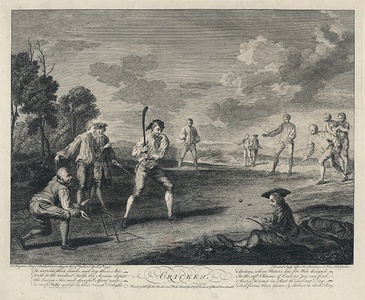| Method | Copper engraving |
| Artist | Antoine Benoist after Francis Hayman |
| Published | Publish'd according to Act of Parliam't. April 4th 1743. Printed & Sold by Tho. Bowles in St. Paul's Church Yard & Jon. Bowles at ye Black Horse, Cornhill. |
| Dimensions | Image 260 x 350 mm, Plate 290 x 365 mm, Sheet 370 x 435 mm |
| Notes |
An incredibly rare and important engraving depicting a cricket game from a series of twelve scenes of pastimes and activities originally painted by Francis Hayman. This is the earliest print depicting cricket in play. One of twelve designs originally painted by Hayman to decorate the supper boxes at Vauxhall Gardens. In the foreground to the left is a batsman by the wicket ready to hit the ball. A wicket keeper is crouched behind him ready to catch the ball, whilst a young boy sits to the right keeping score. The wicket keeper is traditionally said to be a portrait of William Hogarth, a colleague of Hayman's through his teaching at Hogarth's St. Martin's Lane Academy. The game was originaly believed to be taking place on the ground of the Honourable Artillery Company in Finsbury, the earliest definite cricket match being played on this ground in 1730, but this is now disputed. We could trace only two institutional copies of this engraving, The British Museum and Melbourne Cricket Club Museum. Text below image: To exercise their Limbs and try their Art Forth to the verdant Fields the Swains depart: The buxom Air and chearfull Sport unite To make Hulse* useless by their rough Delight, Britons, whom Nature has for War design'd In the soft Charms of Ease no Joy can find: Averse to wast in Rest th' inviting Day Toil forms their Game, & Labour is their Play. *a noted Physician Antoine Benoist (c. 1721-1770) was a French drawing master and engraver. Born in Tracy-le-Mont in Picardy, he was the son of the artist Jean-Isaac Benoist. By 1735 Benoist was living and working in England where he worked with the French engraver Claude du Bosc. Benoist was the first artist to engrave a print of a cricket match, the work being part of a set of designs produced by Francis Hayman, for Vauxhall Gardens, and published in 1743. Benoist also found other employment as a teacher of drawing for wealthy families. Benoist is also known for making a frieze on two plates representing The Grand Procession of the Scald Miserable Masons, dated 1742. He died in London in 1770. Francis Hayman (1708 - 1776) was a painter of history, portrait and genre. Born in Devon in 1708, he apprenticed to Robert Brown in 1718, producing scene paintings for Drury Lane Theatre. He went on to decorate supper boxes and pavilions at Vauxhall Gardens for Jonathan Tyers and he also contributed 31 pictures to a 1744 edition of Shakespeare's plays by Sir Thomas Hanmer, later portraying many leading contemporary actors in Shakespearean roles, including David Garrick as Richard III. Hayman taught at St. Martin's Lane Academy and was involved in the Society of Artists foundation in the 1760's, becoming President in 1766-68, and was also a foundation member of the Royal Academy. He exhibited at the SA 1760-68, and the RA 1769-72. John Bowles (c.1701-1779) was a British printmaker and publisher, and a member of the prolific and numerous Bowles family of printmakers. The second son of Thomas Bowles I, he established a publishing house in his own name following the passing of the family business to his older brother Thomas Bowles II after their father's death. In 1752, his son Carington joined the business, which traded under the name John Bowles & Son until 1764, when Carington took over the running of the original Bowles publishing house from his uncle, Thomas Bowles II. John Bowles specialised in mezzotint, especially portraits, though he also produced numerous topographical series and genre scenes. Siltzer p.341. Condition: Professionally repaired holes to sheet margins. Surface marks to sheet. Old pencil manuscript to top margin. |
| Framing | unmounted |
| Price | £3,750.00 |
| Stock ID | 53325 |

